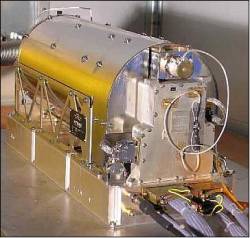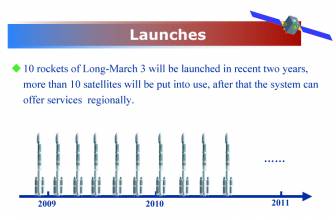According to reports out of China, new, very accurate rubidium atomic clocks onboard two BeiDou-3 satellites launched into space on November 5 have greatly improved the accuracy of the system.
The country launched two BeiDou-3 satellites into space via a single carrier rocket to support its global navigation and positioning network at 11:45 UTC on Sunday (November 5). The satellites were aboard a Long March-3B carrier rocket which took off from Xichang Satellite Launch Center in the southwestern province of Sichuan, according to the China Xinhua News Agency.
According to reports out of China, new, very accurate rubidium atomic clocks onboard two BeiDou-3 satellites launched into space on November 5 have greatly improved the accuracy of the system.
The country launched two BeiDou-3 satellites into space via a single carrier rocket to support its global navigation and positioning network at 11:45 UTC on Sunday (November 5). The satellites were aboard a Long March-3B carrier rocket which took off from Xichang Satellite Launch Center in the southwestern province of Sichuan, according to the China Xinhua News Agency.
The latest launch marks the first two BeiDou-3 satellites launched by China, as its self-developed BeiDou Navigation Satellite System officially began to expand into a global network. China plans to build BeiDou into a global positioning and navigation system by around 2020.
The two satellites are equipped with more reliable rubidium atomic timekeepers than those in previous BeiDou satellites. Yang Changfeng, chief designer of the satellite system, told Xinhua that the stability of the atomic clocks was as high as E-14. “It means only one second of deviation in three million years,” he said, in the published report.
Important payloads of the navigation satellites, atomic clocks are the workhorses which synchronize the signals that allow satnav receivers to triangulate their position on Earth.
“The stability of the new-generation clocks has been improved by 10 times, compared with those carried by BeiDou-2 satellites,” said Qu Yongsheng from the China Aerospace Science and Technology Corporation fifth research institute, Xi’an branch, developer of the clocks.
This new technology is designed to raise the positioning accuracy of the BeiDou-3 to 2.5 to 5 meters, from 10 meters in the past.
Onboard the Long March-3B/Y1 launch vehicle were the Beidou-3M1 (Beidou-24) and Beidou-3M2 (Beidou-25) navigation satellites, the Medium Earth Orbit (MEO) component of the 3rd phase of the Chinese BeiDou (Compass) satellite navigation system. The satellites are part of a fleet that will expand the system to a global navigation coverage.
The satellites are using a new bus that features a phased array antenna for navigation signals and a laser retroreflector, with a launch mass 1,014 kilograms, according to nasaspaceflight.com. Spacecraft dimensions are noted to be 2.25 by 1.0 by 1.22 meters. Usually, the satellites reside in a 21,500 to 21,400 kilometer nominal orbit at 55.5 degrees.
The BeiDou Phase III system includes the migration of its civil BeiDou 1 or B1 signal from 1561.098 MHz to a frequency centered at 1575.42 MHz – the same as the GPS L1 and Galileo E1 civil signals – and its transformation from a quadrature phase shift keying (QPSK) modulation to a multiplexed binary offset carrier modulation similar to the future GPS L1C and Galileo’s E1.
The Phase II B1 open service signal uses QPSK modulation with 4.092 megahertz bandwidth centered at 1561.098 MHz. The current BeiDou constellation spacecraft are transmitting open and authorized signals at B2 (1207.14 MHz) and an authorized service at B3 (1268.52 MHz).
Earlier this year Inside GNSS reported on another BeiDou milestone regarding increased system accuracy. In the spring, BeiDou engineers claimed that a new accurate positioning chip is helping users arrive at their destinations with an error margin of just one to two meters.






